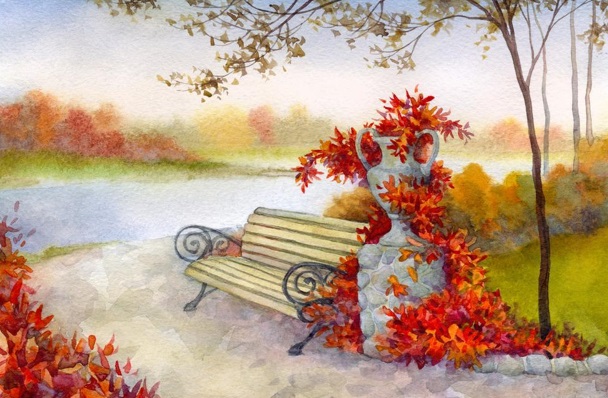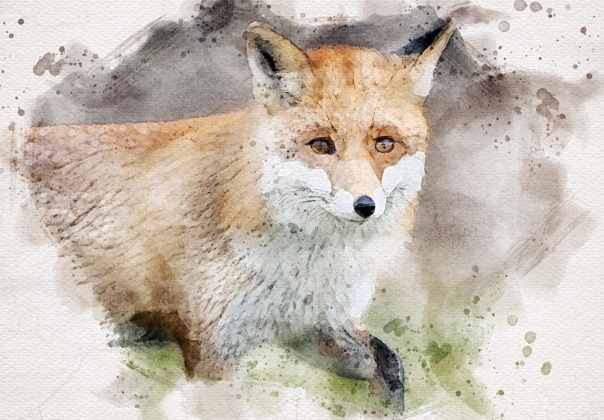When leaves start turning yellow and gracefully falling to the ground, there’s a special melancholic vibe in the air. People experience a touch of sadness and weariness. But is the feeling of autumn melancholy really such a bad thing?
Artists like Vincent Van Gogh, Caspar David Friedrich, Camille Pissarro, and many others created some of their finest works during this season, drawing inspiration from the surrounding nature. You can turn on free nature sounds to immerse yourself in the atmosphere fully. In this article, take a fresh look at the melancholy of this season, explore breathtaking fall pictures, and discover ideas for creating autumn-themed art.

Is autumn and fall the same?
“Fall” and “autumn” are synonymous terms used to describe the season between summer and winter. Although both words are used in American and British English, “fall” is more typical for residents of the United States, while “autumn” is often considered the more formal term.
Dictionary.com indicates that “fall,” originating from the expression “falling leaves,” was the prevalent term in Britain before the 17th century. Subsequently, “autumn” became the more widespread choice.
FAQ: What is the feeling of melancholy?
Melancholy is an internal sense of detachment. When someone feels this emotion, it means they’ve been carrying a lingering sadness for a while. What sets melancholy apart from other similar feelings is the absence of a clear reason behind it. Although this is how modern dictionaries define it, neurobiologist and psychologist Lisa Feldman Barrett argues that everyone experiences emotions differently.
Conveying the lonely melancholy of fall: art ideas
Even though melancholy might feel like an unpleasant experience, many famous artists drew inspiration from this emotion. For example, Van Gogh produced some truly stunning paintings in the fall. One of his standout pieces was featured in the Google Arts & Culture collection.
This artwork is called “Leaf-Fall,” painted by the artist in 1889 during his stay in a psychiatric facility following episodes of unruliness and epileptic seizures. The painting captures the place where Van Gogh found himself, portraying the autumn melancholy atmosphere with its vibrant colors, a lone traveler, and the sensation of swaying leaves.
If you are looking for fall picture ideas to convey that sense of autumn melancholy, renunciation, and solitude, here are several options to discover:
A fox in the autumn forest
With their vivid red fur, foxes are associated with autumn. You can depict these charming creatures in a woodland setting. As the forest transforms into a canvas of yellow and orange hues during this season, it provides a stunning backdrop that complements the fox’s distinctive coat.
To infuse more depth and emotion into your artwork, consider portraying a fox seated near water beneath the graceful willow branches. Seemingly reaching toward the water, the tree adds a touch of longing to the scene. Paired with the fox’s presence, it introduces a subtle melancholic element to your illustration.

Leaf-strewn path
Wandering along autumn paths, you are struck by the faded, wilted leaves that seem to have lost their vitality. They symbolize nature’s need to rest, recharge, and prepare for a new beginning.
Autumn leaves showcase a rich palette of colors: subdued greens, warm oranges, gentle grays, and vibrant yellows. This diversity adds a wonderful contrast to your artwork. You might want to try your hand at watercolor techniques, giving your images a light, airy feel with a touch of sadness, as if the colors are delicately unfolding on the canvas.
FAQ: Is melancholy a bad thing?
Although melancholy tends to be considered a bad emotion, that’s not entirely true. Like any other feeling, it helps people reassess reality and make decisions. Creative minds frequently see melancholy as a valuable and poetic experience, enabling them to find inspiration, uncover the hidden depths of the human soul, and grasp the feelings of others.
Still life with fading light
During the fall, sunlight becomes scarcer, creating a distortion in how people perceive the world. Capturing the tranquility and fading beauty of nature can be achieved through the art of painting still lifes.
In your still lifes, you can depict various autumn-related props like apples, woven baskets, leaves, and sunflowers. Fall pictures with pumpkins also strike a chord with viewers, as they are associated with a bountiful harvest and the diligent efforts required to gather it. Moreover, you can illustrate a jack-o’-lantern, a solemn symbol of Halloween. By playing with light, you can infuse the drawing with a sense of melancholy and even a touch of eeriness.
Fog above a river
There’s something melancholic about morning fog above a river. When you look at scenes like that, you feel uncertain. That’s because the mist has a mysterious quality—you never know what’s hidden in it, and your mind tends to imagine darker images.
To paint a realistic depiction of mist, you need plenty of practice. It’s best to use soft brushes and layer the paint on the canvas gradually. This is crucial to achieve a misty effect and soft, blurry edges.
FAQ: Why is fall so melancholic?
It’s all about the human brain’s biochemistry. When fall arrives, natural light diminishes. According to medical journals, lighting influences serotonin production, a neurotransmitter responsible for the feeling of happiness. Consequently, the less light, the lower the serotonin levels, leading to melancholy and even seasonal depression.
5 well-spoken quotes about fall melancholy
If you’re feeling down during fall, read these quotes to help you embrace the essence of bittersweet melancholy:
- “Anyone who thinks fallen leaves are dead has never watched them dancing on a windy day.” (Shira Tamir).
- “Is not this a true autumn day? Just the still melancholy that I love—that makes life and nature harmonize.” (George Eliot).
- “And all the lives we ever lived and all the lives to be are full of trees and changing leaves…” (Virginia Woolf)
- “Autumn is the hardest season. The leaves are all falling, and they’re falling like they’re falling in love with the ground.” (Andrea Gibson).
- “As long as autumn lasts, I shall not have hands, canvas, and colors enough to paint the beautiful things I see.” (Vincent Van Gogh)
FAQ: Why do you feel weird when fall comes?
You might feel weird in the fall because daylight becomes shorter while your activity dwindles, like nature itself. Moreover, autumn is a nostalgic season when the end of the year is around the corner, prompting reflection on the passage of time.
To sum up
Even though fall might bring a touch of melancholy, sadness, and nostalgia, don’t let it get you down. It’s actually a fantastic season to connect with nature and get creative. Let your emotions flow through your art!
